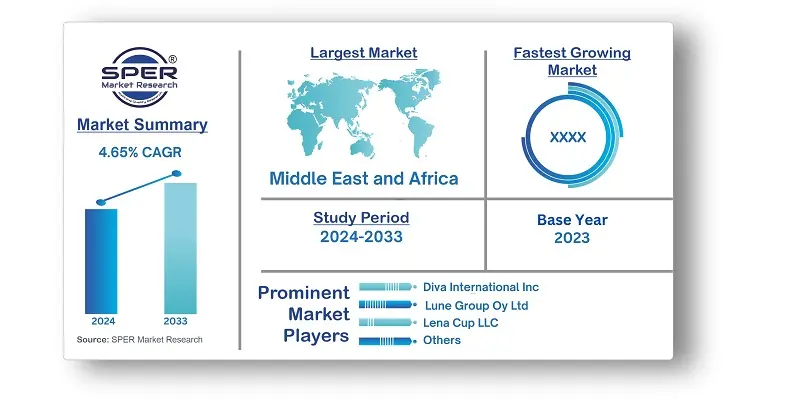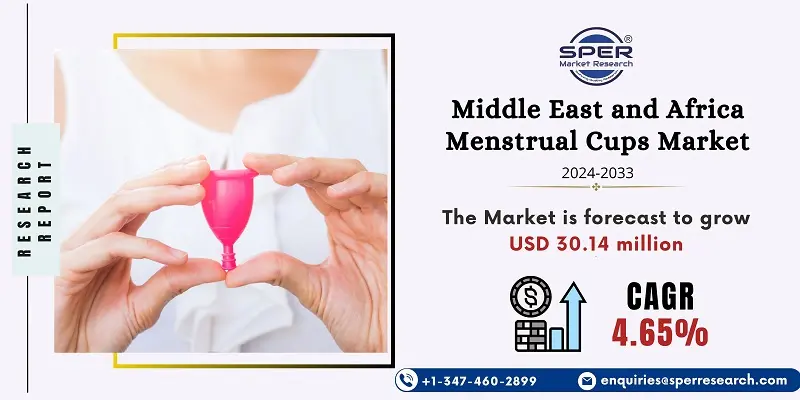
Middle East and Africa Menstrual Cups Market Trends, Share, Demand, Revenue and Future Outlook
Middle East and Africa Menstrual Cups Market Growth, Size, Trends Analysis- By Type, By Distribution Channel- Regional Outlook, Competitive Strategies and Segment Forecast to 2033
| Published: Nov-2024 | Report ID: MEDE2452 | Pages: 1 - 159 | Formats*: |
| Category : Medical Devices | |||
- In August 2019, OrganicCup ApS introduced new, larger, tiny menstruation cups that were too soft to use and composed of premium medical-grade silicone. These little menstruation cups are the most comfortable and environmentally friendly option for teenagers. With the advent of this device, the company was able to increase its product portfolio and increase its market share in the menstrual cup industry.


| Report Metric | Details |
| Market size available for years | 2020-2033 |
| Base year considered | 2023 |
| Forecast period | 2024-2033 |
| Segments covered | By Type, By Distribution Channel |
| Regions covered | Middle East And Africa, Qatar, Saudi Arabia, United Arab Emirates, Egypt, Morocco, Nigeria, South Africa, Rest of Middle-East and Africa |
| Companies Covered | Diva International Inc, Lena Cup LLC, Lune Group Oy Ltd, Pixie Cup LLC, Saalt LLC, The Flex Co, and others. |
- Women Aged 18-45
- Environmentally Conscious Consumers
- Health-Conscious Consumers
- Young Professionals and Students
- Eco-Friendly and Sustainable Product Advocates
- Women in Developing Countries
- Athletes and Active Lifestyle Enthusiasts
- Consumers Seeking Cost-Effective Menstrual Solutions
| By Type: | |
| By Distribution Channel: |
- Middle East and Africa Menstrual Cups Market Size (FY’2024-FY’2033)
- Overview of Middle East and Africa Menstrual Cups Market
- Segmentation of Middle East and Africa Menstrual Cups Market By Type (Medical Grade Silicone, Natural Rubber, Thermoplastic Elastome)
- Segmentation of Middle East and Africa Menstrual Cups Market By Distribution Channel (Pharmacies and Retail Stores, Online Stores, Others)
- Expansion Analysis of Middle East and Africa Menstrual Cups Market
- Problems and Obstacles in Middle East and Africa Menstrual Cups Market
- Competitive Landscape in the Middle East and Africa Menstrual Cups Market
- Impact of COVID-19 and Demonetization on Middle East and Africa Menstrual Cups Market
- Details on Current Investment in Middle East and Africa Menstrual Cups Market
- Competitive Analysis of Middle East and Africa Menstrual Cups Market
- Prominent Players in the Middle East and Africa Menstrual Cups Market
- SWOT Analysis of Middle East and Africa Menstrual Cups Market
- Middle East and Africa Menstrual Cups Market Future Outlook and Projections (FY’2024-FY’2033)
- Recommendations from Analyst
1.1. Scope of the report1.2. Market segment analysis
2.1. Research data source2.1.1. Secondary Data2.1.2. Primary Data2.1.3. SPER’s internal database2.1.4. Premium insight from KOL’s2.2. Market size estimation2.2.1. Top-down and Bottom-up approach2.3. Data triangulation
4.1. Driver, Restraint, Opportunity and Challenges analysis4.1.1. Drivers4.1.2. Restraints4.1.3. Opportunities4.1.4. Challenges4.2. COVID-19 Impacts of the Middle East and Africa Menstrual Cups Market
5.1. SWOT Analysis5.1.1. Strengths5.1.2. Weaknesses5.1.3. Opportunities5.1.4. Threats5.2. PESTEL Analysis5.2.1. Political Landscape5.2.2. Economic Landscape5.2.3. Social Landscape5.2.4. Technological Landscape5.2.5. Environmental Landscape5.2.6. Legal Landscape5.3. PORTER’s Five Forces5.3.1. Bargaining power of suppliers5.3.2. Bargaining power of buyers5.3.3. Threat of Substitute5.3.4. Threat of new entrant5.3.5. Competitive rivalry5.4. Heat Map Analysis
6.1. Middle East and Africa Menstrual Cups Market Manufacturing Base Distribution, Sales Area, Product Type6.2. Mergers & Acquisitions, Partnerships, Product Launch, and Collaboration in Middle East and Africa Menstrual Cups Market
7.1. Middle East and Africa Menstrual Cups Market Size, Share and Forecast, By Type, 2020-20267.2. Middle East and Africa Menstrual Cups Market Size, Share and Forecast, By Type, 2027-20337.3. Medical Grade Silicone7.4. Natural Rubber7.5. Thermoplastic Elastome
8.1. Middle East and Africa Menstrual Cups Market Size, Share and Forecast, By Distribution Channel, 2020-20268.2. Middle East and Africa Menstrual Cups Market Size, Share and Forecast, By Distribution Channel, 2027-20338.3. Pharmacies and Retail Stores8.4. Online Stores8.5. Others
9.1. Middle East and Africa Menstrual Cups Market Size and Market Share
10.1. Middle East and Africa Menstrual Cups Market Size and Market Share By Region (2020-2026)10.2. Middle East and Africa Menstrual Cups Market Size and Market Share By Region (2027-2033)10.3. Middle East And Africa10.4. Qatar10.5. Saudi Arabia10.6. United Arab Emirates10.7. Egypt10.8. Morocco10.9. Nigeria10.10. South Africa10.11. Rest of Middle-East and Africa
11.1. Diva International Inc11.1.1. Company details11.1.2. Financial outlook11.1.3. Product summary11.1.4. Recent developments11.2. Lena Cup LLC11.2.1. Company details11.2.2. Financial outlook11.2.3. Product summary11.2.4. Recent developments11.3. Lune Group Oy Ltd11.3.1. Company details11.3.2. Financial outlook11.3.3. Product summary11.3.4. Recent developments11.4. Pixie Cup LLC11.4.1. Company details11.4.2. Financial outlook11.4.3. Product summary11.4.4. Recent developments11.5. Saalt LLC11.5.1. Company details11.5.2. Financial outlook11.5.3. Product summary11.5.4. Recent developments11.6. The Flex Co11.6.1. Company details11.6.2. Financial outlook11.6.3. Product summary11.6.4. Recent developments11.7. Others
SPER Market Research’s methodology uses great emphasis on primary research to ensure that the market intelligence insights are up to date, reliable and accurate. Primary interviews are done with players involved in each phase of a supply chain to analyze the market forecasting. The secondary research method is used to help you fully understand how the future markets and the spending patterns look likes.
The report is based on in-depth qualitative and quantitative analysis of the Product Market. The quantitative analysis involves the application of various projection and sampling techniques. The qualitative analysis involves primary interviews, surveys, and vendor briefings. The data gathered as a result of these processes are validated through experts opinion. Our research methodology entails an ideal mixture of primary and secondary initiatives.



Frequently Asked Questions About This Report
PLACE AN ORDER
Year End Discount
Sample Report
Pre-Purchase Inquiry
NEED CUSTOMIZATION?
Request CustomizationCALL OR EMAIL US
100% Secure Payment






Related Reports
Our Global Clients
Our data-driven insights have influenced the strategy of 200+ reputed companies across the globe.




















